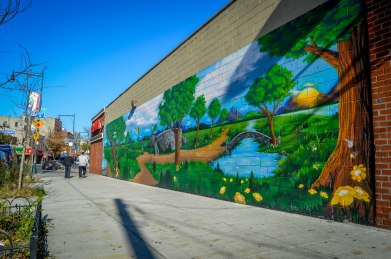At the very end of Arthur Avenue, beyond the D’Auria-Murphy Triangle, is a Rite-Aid. The store itself is nothing special. It does not even have the distinction of being a quintessentially “New York” Duane Reade. But walk around the side of the building that faces St. Barnabas Hospital and your perspective changes. Giant splashes of color adorn the wall in the form of a vibrant and ornate mural created by one of the Bronx’s many well-known graffiti artists.
Known only by his pseudonym, “The Royal Kingbee,” the artist has been commissioned to do art pieces for a variety of businesses, from Rite-Aid to Bacardi. His signature is a giant, angry bee, and it acts as his personal logo and is found in murals all around the Bronx.
Kingbee was born in Harlem and raised in the Bronx. He attended New York City Technical College, where he studied commercial art. Though Kingbee has always loved to create art, his first real exposure to the graffiti scene was in the late 1980s, when he met renowned Bronx artist, “Sak,” a member of a graffiti team called the “MBT Crew.” However, graffitists like Royal Kingbee, Sak and contemporaries — such as “VASE One,” “Nev,” “Bomb5” and “Lady-Di” — did not start the graffiti movement. To discover its origins, we must travel to Philadelphia.
Graffiti was first made, as many things are, to impress a girl. Fourteen year old Daryl McCray, known in graffiti circles as “Cornbread,” tagged his first building in 1967 to attract the attention of his romantic interest. Not long after, McCray and his friends painted their nicknames on buildings and vehicles all over Philadelphia.
The 2 and the 5 trains were especially popular among artists because they were the only easily accessible lines that ran all the way from the Bronx, through Manhattan and into Brooklyn. This exposed the art to a far bigger audience and helped mold graffiti into the integral part of New York culture that it is. Leonard McGurr, known as Futura 2000 in graffiti circles, was a Bronx artist from that era who fondly remembers sitting on the rooftop of his apartment building with his friends and fellow artists, watching the trains go by the Whitlock stop on the Number 6 IRT. They would watch each other’s recent pieces rumble by, trading tricks of the trade, admiration and advice.
By the end of the decade, the sub-culture had died down, having been quashed by the medium’s association with illicit activity. New York City began the Clean Train Movement in 1985 and by 1989, the last graffiti covered subway was removed from service.
Today, on Garrison Avenue, there is a lavishly adorned building that is home to one of the predominant modern graffiti groups. Top Artistic Talents, or more commonly known “TATS Cru,” is composed of four artists, all of whom come from the Bronx. The group’s portfolio includes all the grandiose murals that you might come to expect in the area, but also large advertisements for McDonalds, Snapple, Ford, Dewars and even a Nicki Minaj album. These are by no means traditional ads, though. They grab attention in the same way more traditional graffiti did back in the 70s on the side of inter-borough rapid transit trains.
With the rise of social media platforms, particularly Instagram, the art of TATS Cru has been able to expand its audience, similar to how the 2 and 5 trains helped expand the movement when it began. Artists like The Royal Kingbee and TATS Cru exemplify how graffiti operates in the modern, post-Clean Train Movement era. When combined with the rise of hip-hop music, they represent the impact the Bronx has had in popular and now, corporate, culture.





